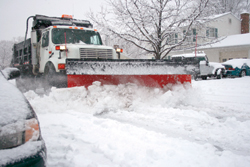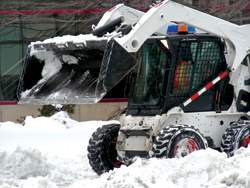The Winter Forecast
 Managing snow and ice is a challenging industry. The unpredictability of weather makes it difficult to forecast for the future, and as this past winter proved, it is not easy to predict what a new season will bring. The 2008-2009 winter season will again be a challenge for both private snow removal service providers and government agencies involved in such work. A number of social, economic and environmental factors will add complexity to the already difficult business of maintaining safe conditions during harsh winter storms.
Managing snow and ice is a challenging industry. The unpredictability of weather makes it difficult to forecast for the future, and as this past winter proved, it is not easy to predict what a new season will bring. The 2008-2009 winter season will again be a challenge for both private snow removal service providers and government agencies involved in such work. A number of social, economic and environmental factors will add complexity to the already difficult business of maintaining safe conditions during harsh winter storms.
These challenges include rising costs of doing business, unpredictable weather conditions, supply of snow and ice removal materials and even pressures of social perception and increased demand for service related to snow and ice removal. Despite these challenges, snow can be viewed as a business stabilizer, as one thing is evident: It will snow and customers are going to need to be serviced. By staying up to date on industry trends and planning for the unexpected, snow and ice professionals can provide safety to the public while continuing to make a profit.
Rising Costs and Economic Challenges
It’s no secret that the cost of doing business is becoming a great challenge for many companies. Cost increases will also strongly affect the snow and ice industry, where heavy equipment and materials are needed to remove snow and ice from parking lots, roadways and other areas. Gas prices, while possibly stabilizing (as of August 2008), still have the potential to be much higher than previous winter seasons. Furthermore, many materials used in the process of melting and removing snow and ice, including de-icing and anti-icing materials, may also be subject to higher prices over the next year. This is especially the case related to rock salt (NaCl) — the most common de-icing material — where supply may be limited due to greater demand from last year’s heavy winter in the Midwest, New England and parts of Canada.
Due to these higher prices, private snow and ice specialists will face a difficult decision: Add fuel surcharges to contracts and risk customer response or absorb these costs into their bottom line. In some cases, contractors have been able to add surcharges successfully. The Snow and Ice Management Association (SIMA) suggests that companies take a hard look at the efficiency of their operations in order to cut costs and prepare for the upcoming season, including these areas:
- Route planning and optimization
- Monitoring of employee/sub-contractor performance (and associated technologies such as GPS)
- Calibration of spreader systems to ensure accuracy
- Use of compact skid steer loaders and other multi-purpose equipment (a continuing trend)
- Use of new plow technologies that increase efficiency (i.e. containment plows, hydraulic/automatic wing-plows, etc.)
- Consider anti-icing as another tool to manage snow and ice
Challenges of Mother Nature
In the past two years, it has become evident that weather patterns across North America and the world are changing. Though political and social factors do play a role in shaping the perception of these issues, there is evidence to support changes in weather and climate. These shifts in weather patterns pose a challenge for snow and ice professionals as winter storms become increasingly difficult to predict. Some interesting sources and facts on changing weather patterns include:
1. *Snow Business State of the Industry Survey 2007-2008 Winter Season (this report is based on 229 reader responses collected through an Internet survey that ended April 16, 2008). Fifty-six percent of respondents reported “far more than average” or “more than average” snowfalls. Broken down by region, these results were reported:
- Seventy percent of Canadian respondents reported far more than average (majority of respondents located in Toronto, Ontario region) vs. 57 percent less than average for 2006-2007.
- In the Northeastern United States (Maine, Vermont, New Hampshire, Massachusetts, Rhode Island and New York), 56 percent experienced average or more than average snowfall, vs. 52 percent far less than average for 2006-2007.
- In the Mid-Atlantic (Southern Pennsylvania, New Jersey, Maryland and Delaware), 76 percent experienced less than or far less than average vs. 48 percent less than average for 2006-2007.
- In the Midwest, 74 percent experienced far more than or more than average vs. 25 percent more than average for 2006-2007.
2. Other data, taken from the National Climatic Data Center (U.S.),** also illustrates some interesting information:
- Of the top 10 warmest years on record in the United States, six of them have occurred within the last 10 years.
- Many cities experienced the snowiest year on record, including:
- Madison, Wis. — 100.1 in. as of March 24, 2008.
- Caribou, Maine — 184.5 in. as of March 2008.
- Milwaukee and Concord, N.H., both ranked the 2007-2008 winter as the second snowiest on record.
As weather patterns change and the overall climate gets warmer, weather is becoming more erratic, especially in regards to snow and ice events. For the snow and ice professional, purchases of materials and equipment will be more challenging, as estimating the average amount of snow per year in the short term may be more difficult.
In addition, the overall structure and pricing models of a snow contractor may negatively affect a company, depending on the type. For example, many contractors in Canada sign contracts for the season, with one price for all service. With a heavy winter like the 2007-2008 season, such a business model can have a substantial negative impact on the bottom line of the company. One solution is to re-structure bidding processes and include a number of contracts and accounts that are either per push, per inch or per event, to offset any exposure from a heavy winter.
Salt Supply Challenges

First, some facts:
- The amount of salt in North America is basically unlimited in quantity — there is no shortage of salt, it is more of an issue of logistics and timing.
- U.S. Government entities do not “seize” salt at the ports or docks; it is not regulated by the government differently than other major commodities and products.
- The majority of the salt sold commercially is sold to government agencies such as state DOTs, municipalities, counties, etc. Private contractors make up a smaller, more fragmented portion of the market. Information for the 2008-2009 winter season indicates that some government agencies are increasing their orders this summer in order to avoid supply concerns during the season, resulting in potentially less supply for the private market. Some suppliers may not be able to service snow and ice contractors due to the increased demand from government sectors.
- In the dead of winter, salt supply may be severely limited due to frozen lakes and rivers, closed roads, rail lines, etc.
What Can Snow Professionals Do?
This season will be a challenge for many snow and ice service providers, but there are a few things that can help manage the situation:
- Be Proactive: Maintain communication with customers and make sure they understand the complexity inherent in managing a steady supply of salt in the midst of high demand and unusual circumstances.
- Form Better Relationships: Contractors should get to know their main supplier of salt on more than just a “call-when-you-need-them” basis. Forming a better relationship also means listening to the supplier and making a strong effort to understand where they are coming from and the challenges they face in their business.
- Get to Know More than One Supplier: Forming more than one relationship is paramount to any business where supply could be an issue.
- Review Salting Practices: Calibrating spreaders can also help monitor usage and ensure that salt isn’t being wasted.
- Consider Anti-Icing: Anti-icing has become a great tool for many contractors in certain situations. While it won’t solve the problem entirely or replace salt, it may help you conserve your supply when times are tight.
- Buy Earlier: Contractors who are willing to purchase now will have better opportunities to secure the salt they need for at least a portion of the
season.
Social and Perceptual Challenges
In the past 10 years, snow and ice professionals, as well as government entities, have been under increasing scrutiny from clients, the media and the general public regarding snow and ice control. Each winter, hundreds of news stories covering heavy storms often contain scathing reviews of municipal or state snow removal services, and public outcries for better service are common. In the United States and Canada, the perception is that any citizen should be able to go about his or her own business or personal life regardless of extreme winter conditions.

As this season moves forward, amidst an economic slowdown, these challenges will remain. Clients of the snow professional will be even more focused on maintaining and meeting budgeted dollars for snow removal, and the public will expect the highest level of service for their tax dollars. Finally, the increased pressure and paradigm change that is taking place in the United States (and has already happened in Canada) related to environmental stewardship and conservation will also begin to add pressure to the industry.
Being proactive in meeting these challenges will separate the strong snow and ice contractor from the pack. Meeting with customers to discuss these challenges before the season begins, monitoring and improving efficiencies in operations, implementing a smart salt plan, using more environmentally safe products for anti-icing and open, honest communication with clients and the media will help snow and ice service providers meet these challenges head-on.
Ellen Kobach is the certification and communications coordinator and Brian Birch is the assistant executive director at the Snow and Ice Management Association (SIMA), based in Milwaukee.
References
1. *Snow Business State of the Industry Survey, May issue, 2008, Questex Media
2. **National Climatic Data Center — www.ncdc.noaa.gov

Comments are closed here.